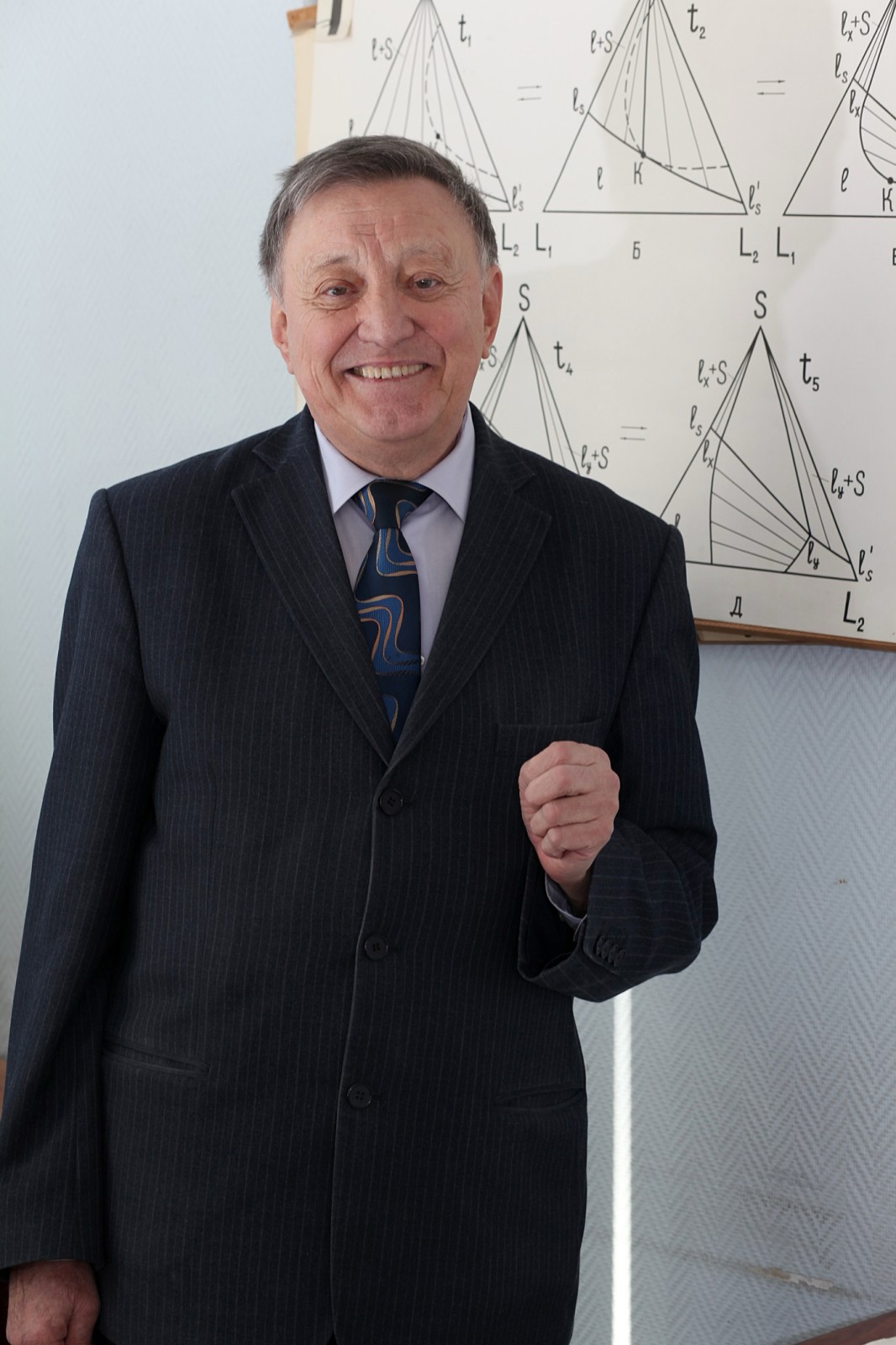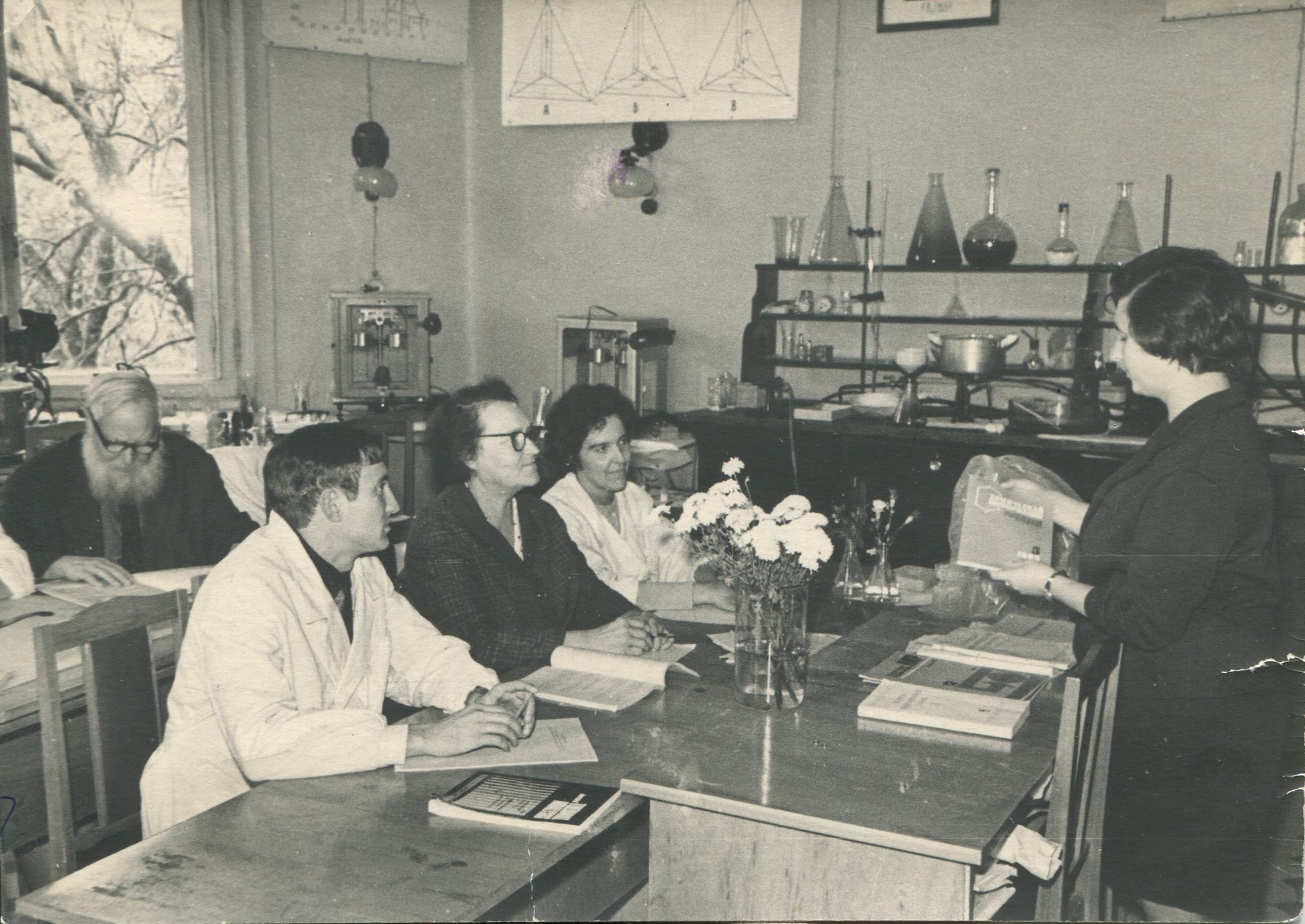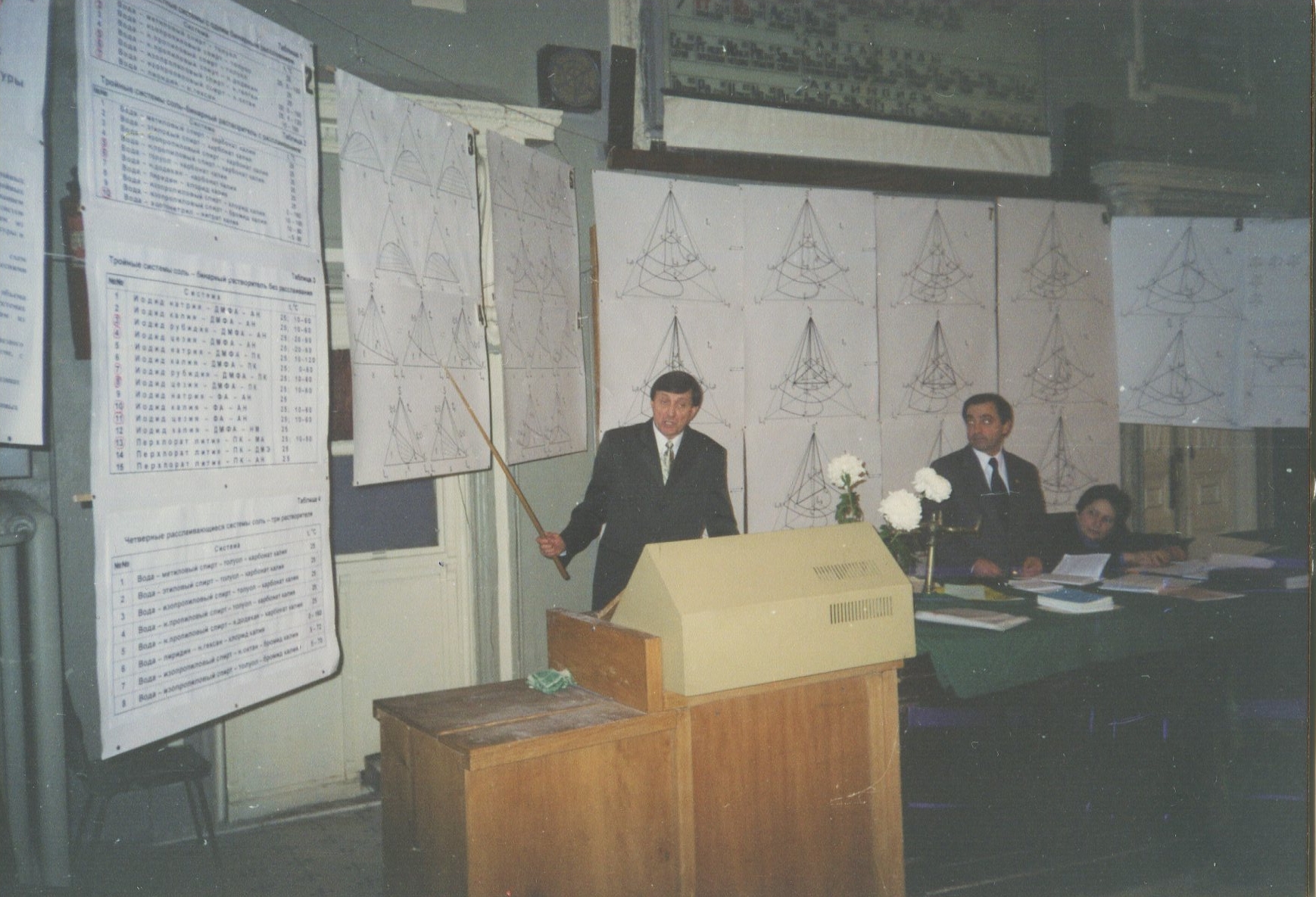
Konstantin Ilyin, Doctor of Chemical Sciences, Professor of the Department of General and Inorganic Chemistry at the Institute of Chemistry, SSU, Honourary Worker of Higher Professional Education of the Russian Federation, a well-known specialist in physical and chemical analysis of multicomponent systems, turned 80 on March 28.
At the age of 80, the former member of the funny and witty movement remains cheerful and resourceful, colleagues and students appreciate his sense of humour, intelligence, openness, easy-going character, and professional strictness. So, we talked almost “on equal terms” with the orchestra man, the last student (as he calls himself) of the legendary chemist Roman Mertslin.
– Professor Ilyin, how conscious was the choice of the Faculty of Chemistry, SSU, at the time?
– Since the eighth grade, I was the head of the chemistry club at School No. 20 in Saratov. I liked this subject, so I did not follow in the footsteps of my older brother, who entered the Faculty of Physics, and decided that I would become a chemist. Although he was fond of physics and geometry, and he knew the history and literature well. But chemistry teachers had a special influence on me. When I was still in School No. 12, in 7th grade, I was struck by Georgii Gil – at the very first chemistry lesson, he poured concentrated sulfuric acid on his hand, we did not have time to gasp, he went to the sink and washed it off, thus, demonstrating that all chemical reactions act in time. We spent unforgettable chemical evenings! On one of them, however, an expensive fur coat was burned to the invited lady… At the end of the experimental performances, rockets were fired along the guide along the wires – for some reason one of them fell.
And in School No. 20, Raisa Ochkina was our chemistry teacher, I met her almost 40 years later, when I sent documents about defending my doctoral dissertation by mail, and she recognised me. ‘That is your influence!’ I told her then.

1969, postgraduate studies

Presentation of doctoral thesis, 2000
– Not all graduates think about a scientific career. Who influenced you so much and you started scientific experiments? Who were your professors?
– I started doing research when I was a third-year student at the Department of Inorganic Chemistry. My scientific supervisor was Assistant Boris Startsev, also a legendary person. He was the author and participant of chemical informal performances, and at first, we got together because of it – he involved me in it. As for science, then I became interested in such a field as the chemistry of rare earth elements. I made presentations at student scientific conferences, won prizes. From the second year of studies, I was a Lenin scholarship holder, I received an increased scholarship of 100 roubles, it was quite a big sum of money, considering that my father earned 88. And somehow, I managed to combine excellent studies with creativity, I was responsible for amateur arts at the faculty. Apparently, the theatrical past had an effect – at the age of 7-8, my brothers and I staged homemade puppet shows on an improvised stage. Then, there was a drama club at school, I was even supposed to enter in drama school. But I decided I would rather be a bad engineer than a bad actor.

Lab staff, 1983
– Your start-up was two years at the SSU Chemistry Research Institute. What did they give you? Did you manage to become a good engineer?
– Working as an engineer in the Department of Inorganic Chemistry at the Research Institute was under an interesting contract related to research for the defence industry, it concerned chemotronics – this is an area that crosses with chemistry (especially electrochemistry) and electronics. We had a very important task – to reproduce and improve the composition of the electrolyte for chemotrons used in rockets and small spacecraft. The electrolyte we developed was then successfully tested in space.
And due to this work with aqueous alcohol solutions of salts, the need to understand the phase states of the studied systems, I aimed at listening to lectures by Professor Roman Mertslin and his student, Associate Professor Natalia Nikurashina on the special course on heterogeneous equilibria in two-, three- and four-component systems. I became interested in this field, and I was offered to enter the postgraduate school. That is how I got two scientific supervisors – Professor Mertslin defined the topic of my PhD thesis, we discussed all the theoretical points with him, and Associate Professor Nikurashina was responsible for the practical part.
It turned out that I was actually the last student of the professor, I was on duty next to him for the last two days of his life…
– Professor Mertslin is one of the rectors of the university, the founder of the scientific school of physical and chemical analysis. On his 110th birthday, you wrote an article, and in the year of his 120th birthday you participated in the filming of a TV show for Saratov television. How do you estimate his scientific legacy today, what personality traits of the teacher seem to you the most valuable?
– Extremely intelligent, he knew perfectly well not only chemistry, physics, mathematics, but also literature and history. Communication with him was enriching in every way. I have always liked passionate people, and he was just like that. The professor promoted his favourite chemistry in such a way that his enthusiasm occupied our impressionable young minds, he literally charmed each of us. Back in my fifth year, I was told, ’Go to Mertslin's special seminar – he is a great scientist!’ At the age of 36, he became a doctor of chemical sciences, bypassing the PhD degree. He was a follower of the teachings of Academician Nikolai Kurnakov and founded the scientific school of physical and chemical analysis at SSU. But, as it often happens, his achievements have been recognised after his death. When I myself participated in international conferences – in Austria, Portugal, in a trip to the USA – and published abstracts at conferences in Japan, England, France, and Italy in absentia, I was always happy to discover that my teacher was known and appreciated by his colleagues in these countries, that his ideas and methods physical and chemical analysis are still in demand today.
Physical and chemical analysis is the basis of materials science. And materials, as it is known, determine scientific and technological progress – both solid (various alloys of metals and salts) and liquid (multicomponent solutions). By the way, Professor Mertslin worked a lot with metal alloys. Before becoming a lecturer at Perm State University, he gained invaluable experience as an engineer at two metallurgical plants.
Extraction of the necessary components from complex mixtures, from solutions, purification, and production of pure substances, all this is very important for various industries. This topic will always be relevant. The widespread use of three- and four-component systems with condensed phase equilibria in various industries, as well as research requires constant development of the theory of phase equilibria.
Since 1985, I have headed this scientific school at the university, when my famous teachers were no longer there. I did not plan to present my doctoral dissertation, because the image of Mertslin was in my mind, his authority prevailed, next to him, I did not see myself as a specialist of the same level. But since SSU was by that time one of the most important centres of physical and chemical analysis in the country, it was often necessary to write reviews of the work of scientists from other universities. Gradually, my colleagues began hinting at the need to write a doctoral thesis. That is why I successfully presented this dissertation only at the age of 56, in 2000, based on the results of many years of research.

Lecture on inorganic chemistry for biologists, 2003
– You have been engaged in research for more than 55 years, which is an achievement in itself. The Department of General and Inorganic Chemistry, where you have been working all your life, has an even richer biography. In fact, it was established together with SSU, in 1909, and university chemistry began with it.
– Yes, our department is unique. Its centenary was recently celebrated, although, in fact, it appeared together with the opening of Saratov State University in 1909 at the Faculty of Medicine.
The scientific group under my leadership is doing the study of topology and topological transformation of phase diagrams of triple and quadruple systems with changes in the nature of components and temperature. These works make it possible to model liquid-phase systems with specified properties, choose optimal systems for extraction processes, and extractive crystallisation of salts, as well as electrolyte compositions for chemical current sources, sensors, and so on.

Conference on chemical thermodynamics, Moscow, 2003
– Your colleagues at the department note that you have a very interesting biography. You have been cooperating with the SSU Student Club for many years, playing in CFW, and travelling. Will you open for us these pages of the life of a university chemist?
– I was at the very origins of the establishment of the SSU Student Club, was a member and chair of the Arts Council. I still have friendly relations with the director of the club, Mark Pinkhasik. He was a member of the satirical group entitled Informal Performance of the Faculty of Chemistry, the Tiny Satire Theatre (TST) directed by a geologist Lev Grodnitskii, played in performances of the Drama Club directed by Honoured Artist of the RSFSR Alexei Bystryakov, as well as the Musical Comedy Theatre, headed by a professor-historian Igor Parfyonov.
Of course, we are all children of CFW. In 1966, the SSU team, captained by Lev Katz, Candidate of Physical and Mathematical Sciences, won an interuniversity game with polytechnics and doctors. I remember I went to buy shoes at a store on Kirov Avenue and was shocked that the sellers recognised me – because then everyone was watching CFW! I still remember our jokes, including those that were outlined…
And how many years have I been a member of amateur artistic teams, travelled all over the country! We had two seasons a year: first, we visited universities in different cities under the Commonwealth programme – Kiev, Tomsk, Tallinn, Leningrad, Moscow, and others. And in the summer, the team used to travel, for example, to Central Asia or along the Kolyma Highway of three and a half thousand kilometres. We travelled around Magadan Region for a whole month, went to the construction sites of Bratsk and the surrounding area, along the entire Angara River to Lake Baikal, travelled through the virgin lands of Kazakhstan, and even visited Kamchatka. In short, our artistic and scientific life was hectical!
And I have visited 25 countries in total, I do not know, is it a lot for a traveller? The trips were connected with both scientific business trips and travel around the world. The most exotic of them is to the Seychelles. Not everyone will decide at the age of 68 to go to the edge of the world, or rather, almost to the equator, to go alone! And I wanted to check if it was true that everything there was like in the picture in the advertising magazine – turquoise ocean, pink sand, palm trees, four-poster bungalows, coconuts, giant turtles, wild rainforest, and strange birds. Well, that is, the biblical Eden. It turned out to be true!

The 45th anniversary of Student Club

The Seychelles, 2012
– Addressing students and postgraduates, your future colleagues, which faculty tradition would you like to preserve and pass on?
– At the centenary of the department in 2022, I said that the most important thing was continuity in science, in ideas, in scientific directions. We continue maintaining this connection. Some of Roman Mertslin's ideas, which he did not implement (and he had a lot of them!), have been further developed. I am sure he would have been more surprised and delighted by this fact than we were.
We have experimentally confirmed many of his hypotheses, we have proposed new modifications of the methods, and developed an original methodology for the polythermal study of phase diagrams. My student Dmitrii Cherkasov successfully defended his PhD and doctoral dissertations. In 2020, we published the joint monograph Topology of phase diagrams of triple salt-two solvent systems with salting in-salting out. In 2022, it took second place in the Natural Sciences nomination of the University Book All-Russian contest.
And another important faculty tradition for me is democracy. Entering the building, Professor Mertslin shook hands with the janitor, the plumber, and the students. And at the same time, he was very strict and scrupulous when he demanded from us a critical interpretation of the results obtained, as well as thoroughness and accuracy in conducting the experiment. Sometimes we argued with him when I tried to substantiate my research with literary data.
Even now, we often argue violently with colleagues, sometimes we disagree. Here, in the Mertslin Research Laboratory of Physical and Chemical Analysis, four teaching staff are working side by side – my student, Professor Dmitrii Cherkasov, his students – Associate Professor Maxim Smotrov and Assistant Veronica Danilina, who has just defended her PhD thesis, and together with us 12 more undergraduate and postgraduate students.
Recently, I stunned first-year students with the statement that if I were making a professional choice again, I would work with wildlife and enter the Faculty of Biology of Lomonosov Moscow State University. All the latest landmark scientific discoveries are made at the crossing of biology and chemistry. And here we have our own idea – to study the phase diagrams of systems with biologically active substances. Maxim Smotrov and Veronica Danilina are already doing such research. I admit that it is very difficult to work with these components, few people in the world receive complete phase diagrams of systems that include biologically active substances. But we will try!
Interview by Tamara Korneva
Translated by Lyudmila Yefremova
The research headed by Prof. Konstantin Ilyin is supported by grants from International Science Foundation, the International Programme of Education in Natural Sciences, and Russian Foundation for Basic Research. The results of the study of five triple systems are included in the international database of physical and chemical data, CODATA.
He has published more than 240 research papers. He has successfully supervised three PhD and one doctoral theses.

Opponent at a doctoral thesis presentation, 2005

China, 2011

China, 2011







